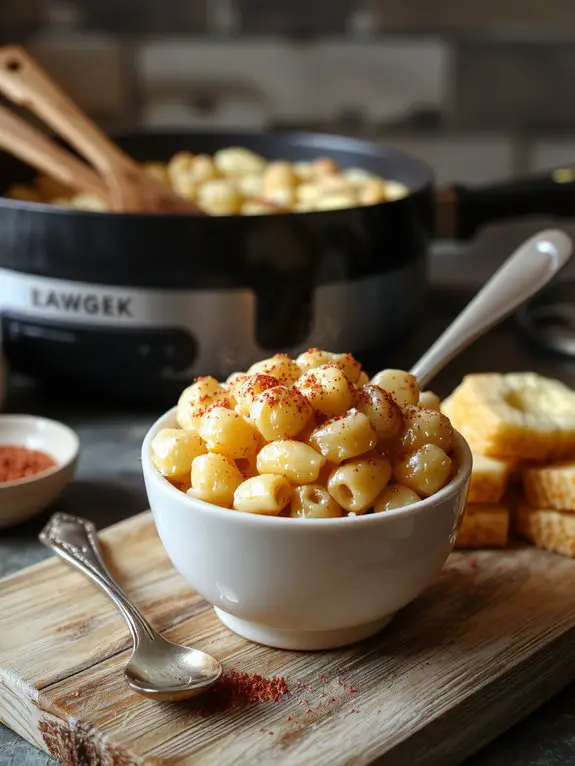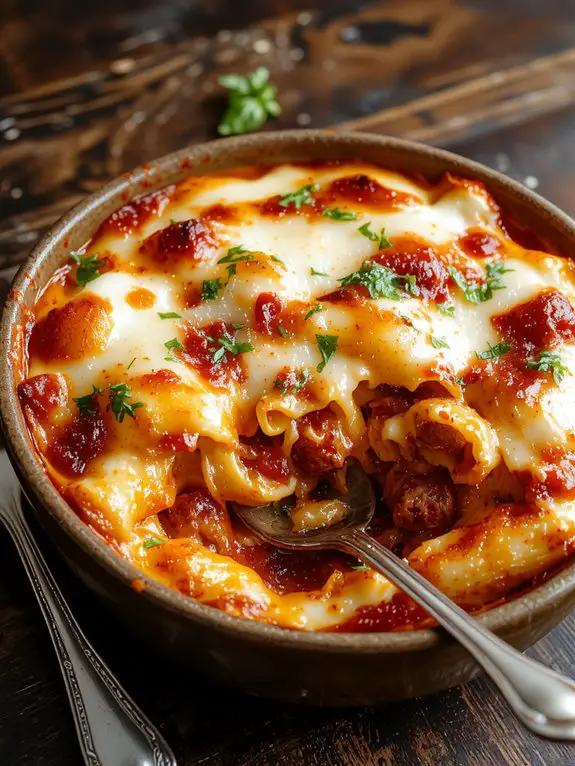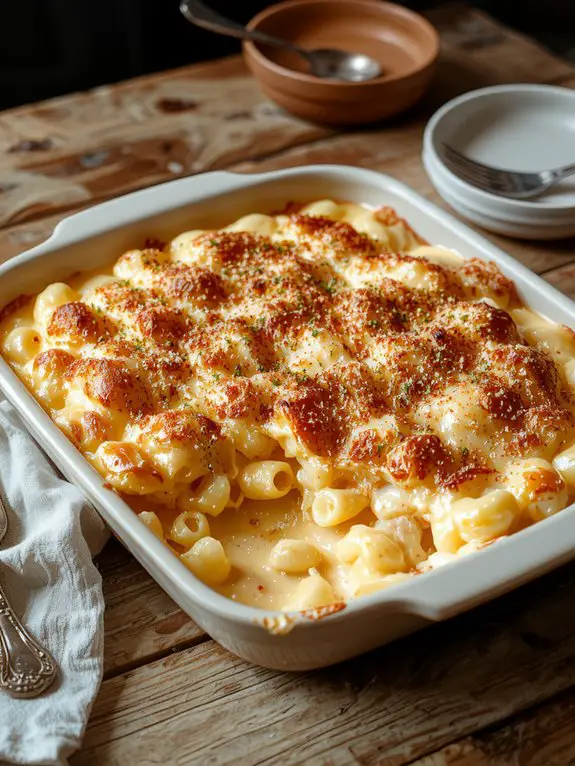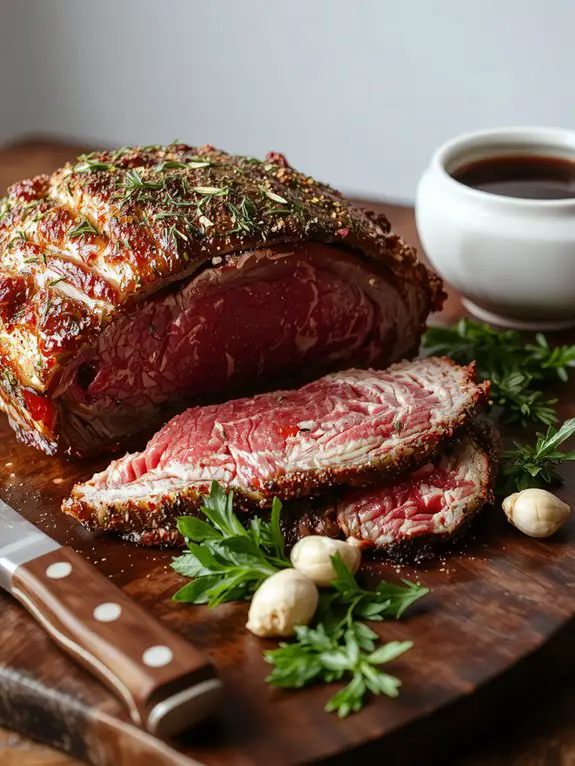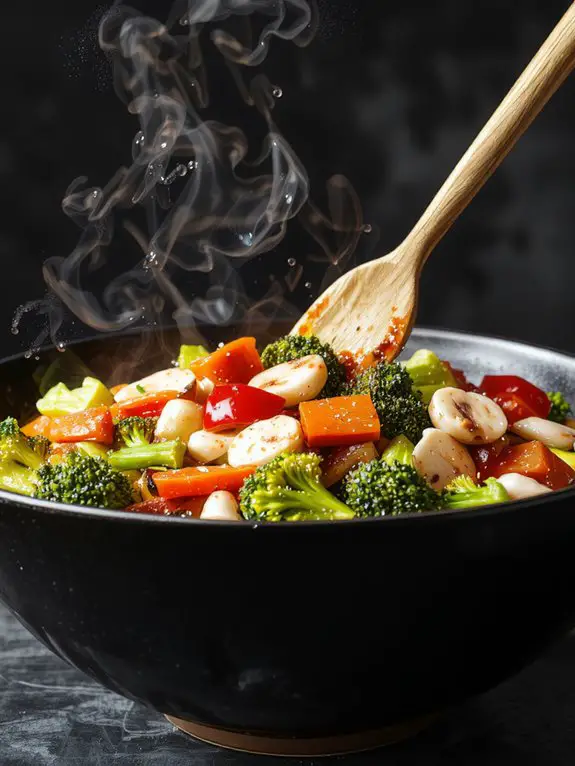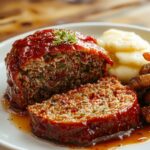I’ve spent years perfecting this mac and cheese recipe, and I can tell you that most versions fall short of their potential. The secret isn’t just about cheese selection or cooking technique—it’s about understanding how each component works together to create that perfect balance of creamy, cheesy comfort. What I’m about to share will transform how you approach this beloved dish forever.
Recipe
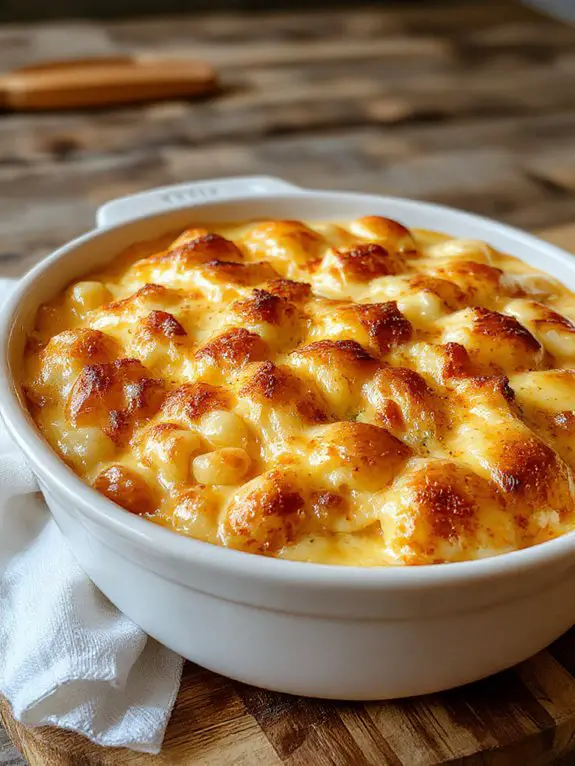
I can vouch for this mac and cheese and tell you with 100% confidence that it will become your go-to comfort food obsession. This isn’t your average boxed version—we’re talking about silky, three-cheese perfection that clings to every single noodle like a warm hug.
The secret? A proper roux-based cheese sauce that starts with real butter and flour, creating that glossy, restaurant-quality texture that never breaks or gets grainy. I’ve made this recipe countless times for family dinners, potlucks, and those nights when you just need something soul-satisfying, and it delivers every single time.
The combination of sharp cheddar, creamy Gruyère, and a touch of Parmesan creates layers of flavor that dance on your tongue—rich and tangy with just the right amount of sharpness. Each forkful gives you that perfect stretch of cheese, tender pasta, and a golden-brown top that adds the most satisfying crunch.
The aroma alone will have everyone gathering in the kitchen before you even call them to dinner. Trust me, once you taste homemade mac and cheese done right—with that perfect balance of creamy interior and crispy edges—you’ll wonder why you ever settled for anything else, and the best part is it’s surprisingly simple to master.
Ingredients

The secret to legendary mac and cheese lies in choosing the right ingredients—and knowing where you can bend the rules. While some swaps are totally fine, there are a few non-negotiables that separate bland cafeteria mac from the silky, indulgent masterpiece you’re craving. Here’s your insider guide to building the ultimate cheese sauce and pasta foundation.
For the Pasta:
- Elbow macaroni (8 oz) – The classic choice with perfect cheese-catching curves, but shells or cavatappi work beautifully too
- Salt for pasta water – Don’t skip this! Generously salted water is your first flavor layer
For the Cheese Sauce Base:
- Butter (4 tablespoons) – Creates that luxurious mouthfeel; margarine just won’t give you the same richness
- All-purpose flour (1/4 cup) – Your thickening agent for a smooth, lump-free sauce
- Whole milk (2 1/2 cups) – The creaminess factor; 2% works in a pinch, but don’t go lower
- Heavy cream (1/2 cup) – This is where the magic happens—skip it and you’ll miss that restaurant-quality silkiness
For the Cheese Blend:
- Sharp cheddar cheese (2 cups, freshly grated) – The star of the show; pre-shredded has anti-caking agents that fight smooth melting
- Gruyère cheese (1 cup, grated) – Your secret weapon for nutty depth that separates good from unforgettable
- Cream cheese (4 oz, softened) – The professional trick for ultra-smooth sauce that never breaks
Seasonings & Flavor Boosters:
- Dijon mustard (1 teaspoon) – Adds tangy complexity without screaming “mustard”
- Garlic powder (1/2 teaspoon) – More mellow than fresh garlic, which can overpower the cheese
- Paprika (1/2 teaspoon) – For warmth and that gorgeous golden color
- Salt and black pepper to taste
- Panko breadcrumbs (1 cup) mixed with melted butter (2 tablespoons) – Optional but highly recommended for that crispy-top contrast
How to Make the Best Classic Stovetop Mac and Cheese

Getting your water properly seasoned from the start guarantees your pasta absorbs flavor as it cooks. Use about 1 tablespoon of salt per 4 quarts of water—it should taste like mild seawater. A large pot prevents overcrowding, which can cause uneven cooking and sticky pasta.
Cook the elbow macaroni according to package directions until just al dente, then drain and set aside.
Al dente means the pasta still has a slight bite when you test it—this prevents mushy mac and cheese since the pasta will continue cooking when mixed with the hot cheese sauce. Reserve about 1/2 cup of the starchy pasta water before draining; you can use this later to adjust the sauce consistency if needed.
In the same pot, melt butter over medium heat until it begins to foam.
Using the same pot saves on cleanup and the residual pasta starch helps thicken your sauce naturally. Watch for the butter to foam and smell nutty—this means the water has evaporated and you’re ready for the next step. Medium heat prevents the butter from burning.
Whisk in flour and cook for 1-2 minutes, stirring constantly to create a smooth roux.
This step eliminates the raw flour taste and creates the base for a silky sauce. Your roux should bubble gently and turn a light golden color. If it starts browning too quickly, lower the heat. Constant whisking prevents lumps and guarantees even cooking.
Gradually add milk while whisking continuously, starting with just a splash at a time.
Adding milk slowly prevents lumps from forming in your cheese sauce. Start with about 1/4 cup, whisk until smooth, then add the rest in a steady stream while whisking. The mixture will look thin at first but will thicken as it heats—trust the process!
Continue cooking and whisking until the sauce thickens enough to coat the back of a spoon, about 3-5 minutes.
You’ll know it’s ready when you can draw a line through the sauce on your spoon with your finger and it doesn’t immediately run together. The sauce should be smooth and creamy, not lumpy. If it seems too thick, add a splash of that reserved pasta water.
Remove the pot from heat and immediately stir in the shredded cheese, one handful at a time.
Taking the pot off heat prevents the cheese from overheating and becoming grainy or stringy. Add cheese gradually—about 1/2 cup at a time—and stir until completely melted before adding more. This guarantees a perfectly smooth, creamy texture every time.
Season with salt, pepper, and any additional spices, then taste and adjust as needed.
Start with about 1/2 teaspoon salt and 1/4 teaspoon pepper, then taste before adding more. Remember that different cheeses have varying salt levels, so always taste first.
A pinch of garlic powder, paprika, or mustard powder can add extra depth without overwhelming the cheese flavor.
Add the cooked pasta back to the pot and gently fold until every piece is coated with cheese sauce.
Use a large spoon or spatula to fold rather than stir aggressively—this prevents breaking the pasta. Make sure every elbow is generously coated. If the sauce seems too thick, add pasta water one tablespoon at a time until you reach your desired consistency.
Serve immediately while hot and creamy, garnishing with extra cheese or a sprinkle of paprika if desired.
Mac and cheese is best enjoyed fresh from the pot when the sauce is at its silkiest. If you need to hold it for a few minutes, cover the pot and stir occasionally to prevent a skin from forming on top. Leftovers can be reheated with a splash of milk to restore creaminess.
Chef Tips
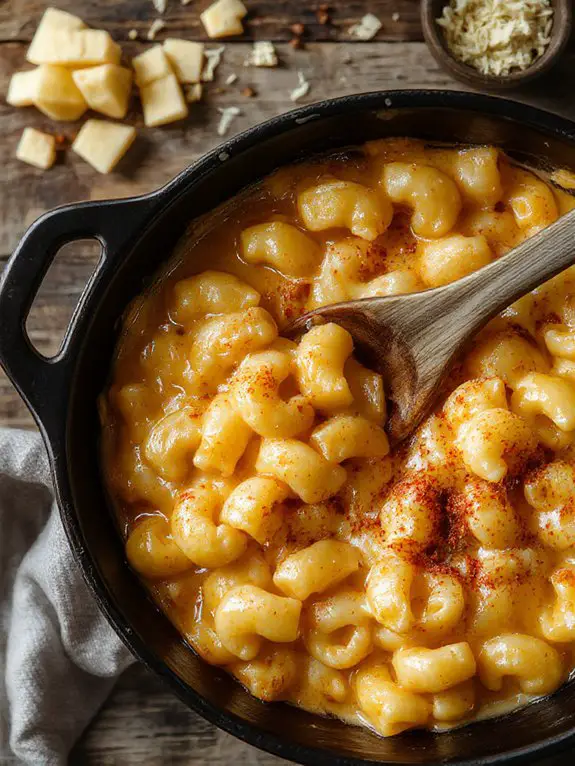
While mastering the basic technique gets you great mac and cheese, a few professional tricks can elevate your dish from good to extraordinary.
I recommend experimenting with flavor pairings like trusting bacon with gruyere or lobster with fontina.
Advanced cooking techniques include tempering your eggs properly and using a pasta water splash for silkiness.
Nutrition
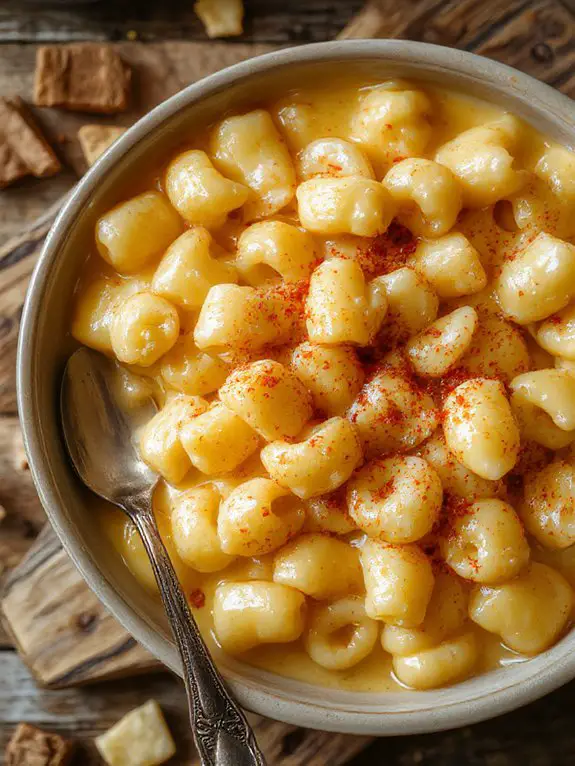
A homemade mac and cheese recipe provides a good source of protein and calcium from the cheese and milk. However, it’s also high in calories and saturated fat, so portion control is important for a balanced diet.
| Nutrient | Amount per Serving (1 cup) |
|---|---|
| Calories | 310 |
| Total Fat | 12g |
| Saturated Fat | 7g |
| Cholesterol | 35mg |
| Sodium | 560mg |
| Total Carbohydrates | 37g |
| Dietary Fiber | 2g |
| Sugars | 6g |
| Protein | 15g |
| Calcium | 285mg |
| Iron | 1.8mg |
| Vitamin A | 380 IU |
| Phosphorus | 240mg |
What You’ll Love About This Recipe
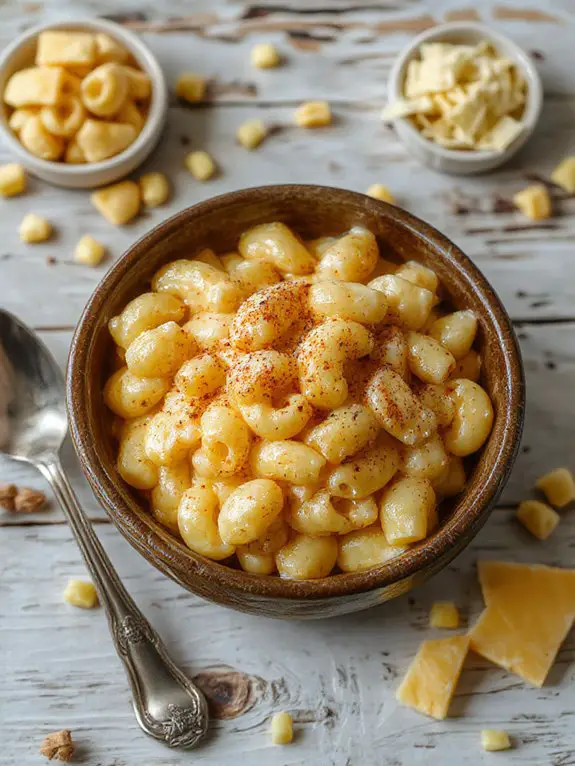
This mac and cheese recipe brings together everything you want in the perfect comfort food dish, with a creamy cheese sauce that coats every noodle and a golden, bubbly top that makes your mouth water. Whether you’re feeding hungry kids on a weeknight or bringing a crowd-pleasing side to your next potluck, this recipe delivers the kind of satisfaction that keeps everyone coming back for seconds.
Simple ingredients you probably already have – No need for fancy cheeses or hard-to-find items, just basic pantry staples that create amazing flavor when combined properly.
Ready in under an hour – From start to finish, you’ll have this comforting dish on the table quickly, making it perfect for busy weeknights when you need something hearty and delicious.
Feeds a crowd without breaking the budget – This recipe stretches to serve plenty of people while keeping costs low, so you can enjoy restaurant-quality mac and cheese at home without spending a fortune.
Recipe Card
This classic mac and cheese recipe delivers the perfect combination of creamy, cheesy comfort in every bite. Made with tender elbow macaroni and a rich cheese sauce, this homestyle favorite is ideal for family dinners, potlucks, or whenever you’re craving ultimate comfort food.
Ingredients:
- 1 pound elbow macaroni
- 4 tablespoons butter
- 4 tablespoons all-purpose flour
- 3 cups whole milk
- 2 cups sharp cheddar cheese, shredded
- 1 cup Gruyere cheese, shredded
- 1 teaspoon salt
- 1/2 teaspoon black pepper
- 1/4 teaspoon paprika
- 1/2 cup panko breadcrumbs
- 2 tablespoons butter, melted
Instructions:
- Preheat oven to 375°F and grease a 9×13 inch baking dish.
- Cook macaroni according to package directions until al dente. Drain and set aside.
- In a large saucepan, melt 4 tablespoons butter over medium heat. Whisk in flour and cook for 1 minute.
- Gradually add milk, whisking constantly until smooth. Cook until thickened, about 5 minutes.
- Remove from heat and stir in cheddar and Gruyere cheeses until melted. Season with salt, pepper, and paprika.
- Combine cooked macaroni with cheese sauce and transfer to prepared baking dish.
- Mix panko breadcrumbs with melted butter and sprinkle over top.
- Bake for 25-30 minutes until golden and bubbly.
Notes:
For extra creaminess, add 4 ounces of cream cheese to the sauce. Cheese can be substituted with other varieties like Monterey Jack or Gouda. Leftovers keep in refrigerator for 3-4 days.
Equipment:
Large pot, whisk, saucepan, 9×13 inch baking dish, measuring cups
Time:
Prep time: 15 minutes
Cooking time: 30 minutes
Cuisine: American
Serving: 8 servings

